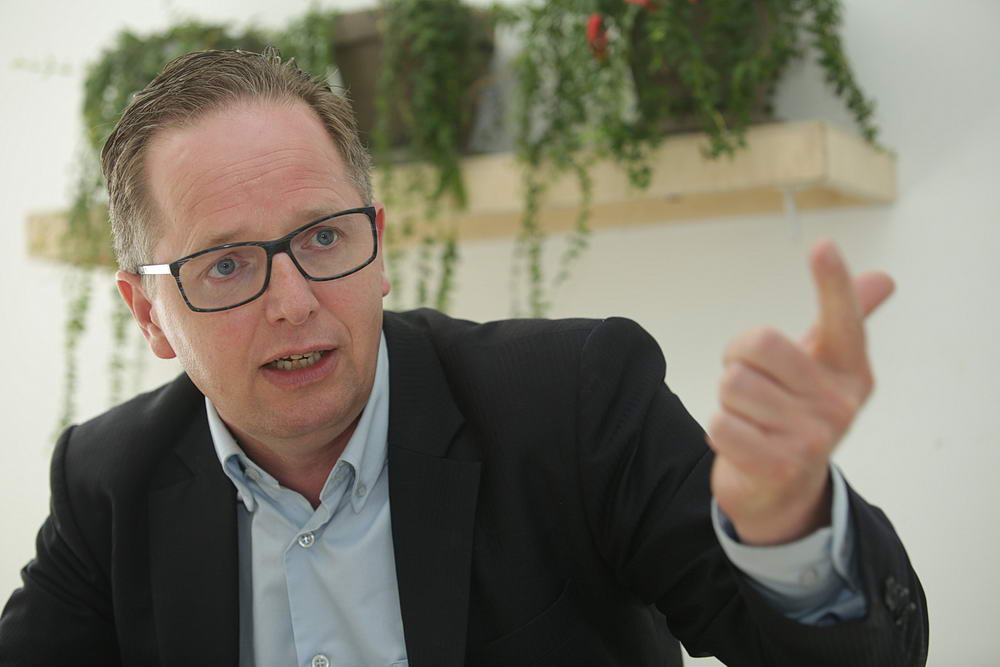Ukraine’s agricultural sector is thriving on grain and vegetable exports. But the world’s second-largest agricultural exporter, the Netherlands, hopes Ukrainian dairy and beef producers see some success too.
The Netherlands — although 14 times smaller than Ukraine by land area — is a key global food producer. In 2017, Dutch agriculture exports were worth a total of 92 billion euros — more than Ukraine’s entire gross domestic product.
Andriy Yarmak, an economist for the United Nations’ Food and Agriculture Organization, speaking at the first Ukrainian Beef Congress in November 2017, said Ukraine’s beef industry alone could reach $2 billion with better technology and feeding practices.
Supported by their government, Dutch companies are trying to help Ukrainian farmers hit that goal.
Better practices
Vasyl Stoika, the production director at the Saltivsky meat processing plant in Kharkiv, is inspired by Dutch slaughterhouses. He recently visited the Netherlands for the first time as part of the FoodTechLink program.
“Our plant now buys meat from farmers and makes sausages and other products of it,” he said.
“But we plan to open our own slaughterhouse, and we will definitely borrow ideas from the Dutch.”
Launched in 2015, FoodTechLink takes Ukrainian agro-producers and food processing enterprises on a tour to Dutch companies where they can better learn about the technology that has made the Netherlands a top global food exporter.
Benno Grimberg, coordinator of the FoodTechLink, says that Ukrainians are interested in new technologies.
“Most of them are eager to modernize or extend their own slaughterhouse processing lines and cold storages,” he told the Kyiv Post in an e-mail.
But to learn from the best, it isn’t necessary for Ukrainians to travel abroad. Many Dutch companies work in Ukraine or partner with the Dutch-Ukrainian Dairy Center, a three-year training program run by a consortium of three Dutch companies and HAS University of Applied Sciences.
The program, which started in 2016, is funded by the Dutch government and in two years already trained 600 farmers all over Ukraine.

Kind to cows
One focus of the Dutch agricultural experts has been treating livestock better, both for humane reasons and profit.
Thanks to the Dutch-Ukrainian Dairy Center, Ukraine now has eight certified trainers in CowSignals — a course that teaches farmers to understand cow behavior and organize dairy farms to maximize the livestock’s comfort and health.
Another consortium partner, GD Animal Health, teaches veterinary diagnostics. And a dozen other Dutch partners are introducing their latest dairy farm equipment and innovations in cow breed genetics and grass seeds for cow feed.
Caring for livestock well isn’t always a straightforward task.
“There’s no one magic solution, like Ukrainian farmers want,” says Rene Kremers, project manager at the Dutch-Ukrainian Dairy Center and director of one of consortium partners DIFCO International.
“It’s a combination of different practices and modern equipment.”
Kremers say that Dutch meat and dairy production is based on the principles of animal welfare, disease prevention, strict quality control, not using antibiotics and hormones, improving genetics, and top-quality feed.
Taken together, these practices improve the cow’s lifetime productivity and increase milk production.
As for Ukrainian farmers, Kremers call them conservative. Some still practice tail-cutting, which is forbidden in the Netherlands.
“It’s important to change the mentality of Ukrainian farmers (for them to understand) that they need to invest in training and equipment,” Kremers said.
For most Ukrainians, adopting better beef and dairy practices is a question of money.
“Ukrainian consumers and supermarkets aren’t very demanding,” says Kremers.
Ukrainian dairy farmer Yaroslav Kolomiets, who also went on the FoodTechLink tour, says that the amount of government support to agribusiness in the Netherlands is incomparable to that in Ukraine.
“The state approach is different there,” said Kolomiets, who manages a dairy farm in a village near Bila Tserkva, which has 1,600 heads of cattle and sells 20 tons of milk daily.
“They have a lot of financial and institutional support. They are far more advanced.”

Dutch enterpreneur Rene Kremers talks about the Dutch-Ukrainian Dairy Center that trains Ukrainian dairy and meat producers on April 23 in Kyiv. (Kostyantyn Chernichkin)
Land of opportunity
Kremers sees a lot of opportunities in Ukraine. The country recently entered a political and economic association agreement with the European Union — but before it can benefit from free trade, Ukraine has to raise its product quality standards.
“We hope our program will help, but it’s something Ukrainian meat and dairy producers have to do for themselves,” he said.
“Today, they still mainly focus on the local market, which doesn’t have much purchasing power or high demands for quality.”
Still, there are promising directions for Ukrainian beef, domestically and abroad. While some European countries have moved to ban halal slaughtering, putting animal welfare before religion, Europe’s Muslim population is there to stay.
This creates an industry niche that Ukraine could take advantage of for its halal beef exports, Kremers say. Halal certification would also open the North Africa and Middle East, markets to which Ukraine already exports chicken.
Another opportunity could be exports of veal to Europe. But Ukrainian meat producers are more hesitant here, Kremers says.
“For the best quality veal, bull calves need top quality feed and should be slaughtered at eight months,” he said. “But it’s hard to convince Ukrainian farmers to do that”
Money isn’t the only concern. Livestock breeding has a huge impact on the climate. Environmental activists have been calling for a cut meat consumption to reduce methane gas emissions produced by the cattle’s digestive processes and manure.
Dutch dairy producers believe that increasing the longevity of cows to five years — it is currently 3.5 years in Netherlands, and under two years in other countries — could reduce methane emissions by 30 percent. In addition, over 600 Dutch dairy farms will install roof solar panels to use clean energy, Kremers said.
